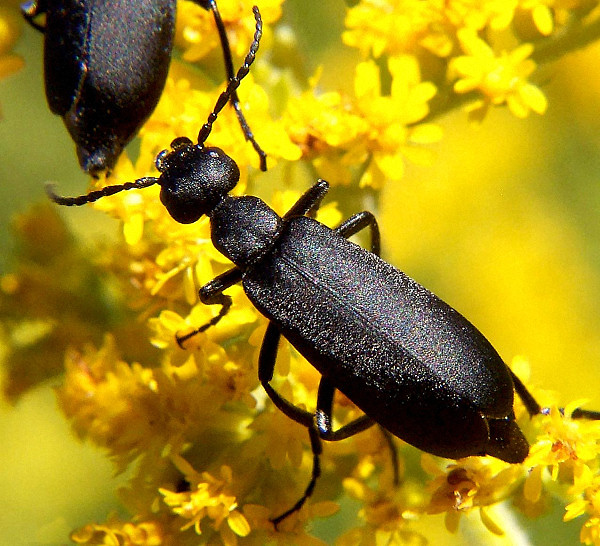One of the big pushes that has come up in popular science is to use insects as a food source for humans because of their high protein, low fat, and relatively low ecological impact. In fact, I wrote a blog post about it a
few months ago. However, insects have been eaten by other animals for millions of years, and may provide the majority of the nutrition in their diets. Which brings me to two topics we're going to write about today: insect chemical defense against getting eaten, and chemical warfare.
The first part is because my dog-owning friends have sent me images of potentially toxic beetles that they found their dogs munching on, or about to munch on. Even though domestic dogs primarily are carnivores, its well known that many dogs will eat other stuff if they can get their paws on them. Garbage, scraps...etc. It should be no surprise then that many dogs, if given the opportunity, will eat bugs. Especially if it peaks their hunting instinct, and they get to chase them around. There is a whole blog article musing about
why dogs eat bugs, but for the most part its not really that dangerous. But, what if the beetle they do decide to go after IS actually a problem? Well, the two beetles that my friends sent me images of actually CAN cause a problem, and here is why.
 |
| Black Blister Beetle. Image of Epicauta pennsylvanica by Bruce Marlin. From wikipedia.com |
There is a group of beetles that we have here in Oklahoma and the United States called the Blister Beetles (Meloidae), and they get their name because in their blood they have a caustic chemical called
cantharidin. This chemical, when secreted by the beetle in self defense, can actually burn your skin or even cause blisters (hence their name). Blister beetles can be anywhere from 2cm to as large as 6-8cm (the size of a quarter or so). The largest group of these beetles we usually run into here in Oklahoma is in the genus
Meloe, called the
Oil Beetles. These big, black beetles with a very large, bulbous abdomen ("butt" area), and are usually found wandering along the ground since they cannot fly. There are other beetles in the group that aren't as big and tend to be more rectangular in shape (see
here for more info about the various kinds in North America), but all blister beetles tend to have big, round heads that are wider than the area behind the head, giving them an upside down, exclamation point appearance (!).
My friend that caught her dog actually munching on the beetle before spitting it out unfortunately had her dog dealing with some of the symptoms of the cantharidin: upset stomach, hurting mouth, and other irritation. My other friend caught the beetle before her puppy could find it. Its unlikely that the dogs would die from eating one beetle, but if enough are eaten they can get fatal cantharidin poisoning, which is a major problem in horses.
Not all animals have problems with poisonous insects, however.
Poison dart frogs, for example, actually use the poison in the bugs they eat to make the poison on their skin to protect themselves. In fact, the poison in some dart frogs are some of the strongest poisons known on earth! How the frogs get the poison from their diet to their skin without dying from it is still an active area of research. However, its known that captive-bred dart frogs are not nearly as poisonous as their native colleagues because they don't have access to poisonous insects from their native habitat.
 |
| Briefly holding a wild Dendrobates auratus I found in Costa Rica, outside of our hotel in Manuel Antonio. The owner of the hotel, who knew of the population, had tried to hold one of the frogs to keep it away from some plumbing being re-done near a wall against the forest, trying to protect it. Apparently he held it so long the toxins leached into his skin just holding it. The story goes that one of his workers found him passed out on the floor, with the frog happily hopping all over him on its way back to the forest after. He was fine, and the frog was too. |
 |
| Captive poison dart-frog, which doesn't have the toxins. |
In the tropics there are many cases of chemical warfare between insects and their predators, with poison dart frogs being the masters by beating the system. Those of us who live in the temperate regions of the world also have toxic insects, but few animals that can beat their system and not be affected by the poison or use it in another way. There are examples of animals here in North America that can, which I'll write more about later, but dogs are not one of them.
If you have a dog here in Oklahoma, 99% of the bugs and beetles your dog may eat are not going to be a problem for them. You are more likely going to have problems with your dog eating garbage, poop, coffee, or chocolate than you are with a small beetle. However, if you do find a beetle that looks like the Blister Beetle above and your dog is showing some symptoms of an upset stomach, you may want to have your dog checked out due to the exposure to cantharidin. More than likely it will be nothing, but better safe than sorry.
Have a Happy Holiday!



No comments:
Post a Comment